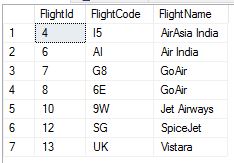What
are Joins?
Note: Except for the case
of Cross join the on clause is eliminated from the query.
We will understand joins by taking a simple example.
Joins: Joins are used to merge two or more table on behalf of
foreign key and primary key relationship to retrieve multiple data. It means
foreign key column of one table points to primary key of another table. That’s
the reason they are preferred over sub-query to fetch records in much faster
way.
Types
of SQL Server Joins
SQL Server
Join are of 3 types: -
o
Inner Join
or Join: Inner join are those join which give only the matched rows
from the table on which join is applied.
o
Outer Join
Outer join is
sub-categorized into 3 types:
o
Left Outer
Join or Left Join: Left outer join are those join which give all rows from
left table and only the matched row from the other table on which join is
applied.
o
Right Outer
Join or Right Join: Right outer join are those join which give all rows from
right table and only the matched row from the other table on which join is
applied.
o
Full Outer
Join: Full outer join are those join which give all rows from
left table and all rows from left table.
o
Cross Join: Cross
join are those join which give the cartesian products of tables on which the
join is applied. Cartesian product means each row from left table is matched
with each row from right table.
Under mentioned is
the syntax of join in select query.
--Basic syntax of join
select columnsNameThatYouWantToShow
from NameOfTableA
as aliasNameOfTableA
JoinType NameOfTableB as aliasNameOfTableB
on aliasNameOfTableA.ForeignKeyColumn = aliasNameOfTableB.PrimaryKeyColumn
We will understand joins by taking a simple example.
Ques- Let’s suppose we have two tables - Flight table and
Passenger table. Now, we will see how to use all the above mentioned join on
table in real scenario.
Practical Implementation:
Step-1: Creation of table.
First
create passenger table which is going
to contain 3 columns: PassengerId which is primary key column, PassengerName
and FlightId which act as a foreign key column for our next table flight. The script is under mentioned:
--Creating table tblPassengers
create table tblPassengers
(
PassengerId int primary key,
PassengerName varchar(10),
FlightId int,
constraint FK_tblFlight_FlightId foreign key(FlightId) references tblFlight(FlightId)
)
Now, create
flight table which is going to
contain 3 columns: FlightId which is primary key column, FlightCode and
FlightName. The script is under mentioned:
--Creating table tblFlight
create table tblFlight
(
FlightId int primary key,
FlightCode varchar(2),
FlightName varchar(15)
)
Step-2: Inserting values in tables.
Insert command to
populate values in passenger table.
The script is under mentioned:
--Inserting records in
tblPassengers
insert into tblPassengers(PassengerId, PassengerName, FlightId) values(1,'Shalu',4)
insert into tblPassengers(PassengerId, PassengerName, FlightId) values(2,'Pranav',8)
insert into tblPassengers(PassengerId, PassengerName, FlightId) values(3,'Nitesh',12)
insert into tblPassengers(PassengerId, PassengerName, FlightId) values(5,'Prashant',1)
insert into tblPassengers(PassengerId, PassengerName, FlightId) values(6,'Sanjay',3)
insert into tblPassengers(PassengerId, PassengerName, FlightId) values(8,'Deepika',5)
insert into tblPassengers(PassengerId, PassengerName, FlightId) values(9,'Pooja',13)
insert into tblPassengers(PassengerId, PassengerName, FlightId) values(11,'Abhinav',4)
Insert command to
populate values in flight table. The
script is under mentioned:
--Inserting records in tblFlight
insert into tblFlight(FlightId, FlightCode, FlightName) values(4,'I5','AirAsia India')
insert into tblFlight(FlightId, FlightCode, FlightName) values(6,'AI','Air India')
insert into tblFlight(FlightId, FlightCode, FlightName) values(7,'G8','GoAir')
insert into tblFlight(FlightId, FlightCode, FlightName) values(8,'6E','GoAir')
insert into tblFlight(FlightId, FlightCode, FlightName) values(10,'9W','Jet Airways')
insert into tblFlight(FlightId, FlightCode, FlightName) values(12,'SG','SpiceJet')
insert into tblFlight(FlightId, FlightCode, FlightName) values(13,'UK','Vistara')
Step-3: Showing the values in table as per our query.
--Returning result from
tblPassengers
select * from tblPassengers
--Returning result from tblFlight
select * from tblFlight
For any
query, comment us below.
Next – Types of SQL Server Joins #2
Keep learning and sharing...

 Technologies
Technologies



No comments:
Post a Comment